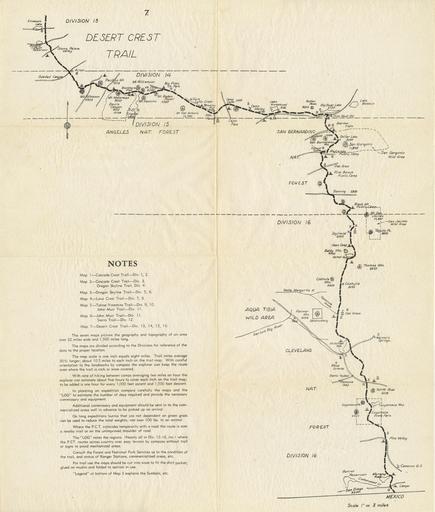MAKE A MEME
View Large Image

| View Original: | 1945_Pacific_Crest_Trailway_7.jpg (6797x7997) | |||
| Download: | Original | Medium | Small | Thumb |
| Courtesy of: | www.flickr.com | More Like This | ||
| Keywords: pct pacific crest trail cacade clinton clarke clintonclarke text drawing sketch document writing monochrome Map 7 of 7 NOTES Map 1 Cascade Crest Trail-Div. 1, 2. Map 2 Cascade Crest Trail-Div. 3. Oregon Skyline Trail, Div. 4. Map 3 Oregon Skyline Trail-Div. 5, 6. Map 4 Lava Crest Trail-Div. 7, 8. Map 5 Tahoe-Yosemite Trail-Div. 9, 10. John Muir Trail-Div. 11. Map 6 John Muir Trail-Div. 11. Sierra Trail-Div. 12. Map 7 Desert Crest Trail-Div. 13, 14, 15, 16. The seven maps picture the geography and topography of an area over 32 miles wide and 1,500 miles long. The maps are divided according to the Divisions for reference of the data to the proper location. The map scale is one inch equals eight miles. Trail miles average 30% longer; about 10.5 miles to each inch on the trail map. With careful orientation to the landmarks by compass the explorer can keep the route even where the trail is rock or snow covered. With rate of hiking between camps averaging two miles an hour the explorer can estimate about five hours to cover each inch on the trail map; to be added is one hour for every 1,000 feet ascent and 1,500 feet descent. In planning an expedition compare carefully the maps and the "LOG" to estimate the number of days required and provide the necessary commissary and equipment. Additional commissary and equipment should be sent in to the commercialized areas well in advance to be picked up on arrival. On long expeditions burros that are not dependent on green grass can be used to reduce the total weights; not over 100 lbs. to an animal. Where the P.CT. coincides temporarily with a road the route is over a nearby trail or on the unimproved shoulder of road. The "LOG" notes the regions. (Nearly all in Div. 12-16, inc.) where the P.C.T. routes across country over easy terrain by compass without trail or signs to avoid mechanized areas. Consult the Forest and National Park Services as to the condition of the trail, and status of Ranger Stations, commercialized areas, etc. For trail use the maps should be cut into sizes to fit the shirt pocket, glued on muslin and folded to section in use. "Legend" at bottom of Map 3 explains the Symbols, etc. Scanned from maps included with the 1945 book Pacific Crest Trailway by Clinton Clarke Map 7 of 7 NOTES Map 1 Cascade Crest Trail-Div. 1, 2. Map 2 Cascade Crest Trail-Div. 3. Oregon Skyline Trail, Div. 4. Map 3 Oregon Skyline Trail-Div. 5, 6. Map 4 Lava Crest Trail-Div. 7, 8. Map 5 Tahoe-Yosemite Trail-Div. 9, 10. John Muir Trail-Div. 11. Map 6 John Muir Trail-Div. 11. Sierra Trail-Div. 12. Map 7 Desert Crest Trail-Div. 13, 14, 15, 16. The seven maps picture the geography and topography of an area over 32 miles wide and 1,500 miles long. The maps are divided according to the Divisions for reference of the data to the proper location. The map scale is one inch equals eight miles. Trail miles average 30% longer; about 10.5 miles to each inch on the trail map. With careful orientation to the landmarks by compass the explorer can keep the route even where the trail is rock or snow covered. With rate of hiking between camps averaging two miles an hour the explorer can estimate about five hours to cover each inch on the trail map; to be added is one hour for every 1,000 feet ascent and 1,500 feet descent. In planning an expedition compare carefully the maps and the "LOG" to estimate the number of days required and provide the necessary commissary and equipment. Additional commissary and equipment should be sent in to the commercialized areas well in advance to be picked up on arrival. On long expeditions burros that are not dependent on green grass can be used to reduce the total weights; not over 100 lbs. to an animal. Where the P.CT. coincides temporarily with a road the route is over a nearby trail or on the unimproved shoulder of road. The "LOG" notes the regions. (Nearly all in Div. 12-16, inc.) where the P.C.T. routes across country over easy terrain by compass without trail or signs to avoid mechanized areas. Consult the Forest and National Park Services as to the condition of the trail, and status of Ranger Stations, commercialized areas, etc. For trail use the maps should be cut into sizes to fit the shirt pocket, glued on muslin and folded to section in use. "Legend" at bottom of Map 3 explains the Symbols, etc. Scanned from maps included with the 1945 book Pacific Crest Trailway by Clinton Clarke | ||||